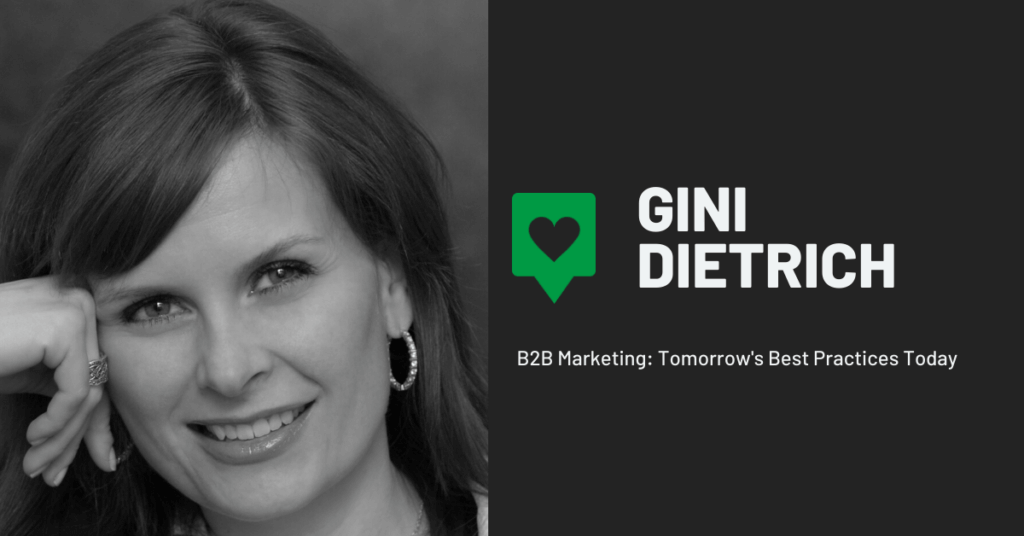In B2B Marketing: Tomorrow’s Best Practices Today, we feature expert interviews about the state of B2B Marketing and what the future holds. In this post, I interview Gini Dietrich, CEO of Spin Sucks.
Tell us about yourself?

If that isn’t a loaded question…the quick bio is I’m the founder, CEO, and author of Spin Sucks, host of the Spin Sucks podcast, and author of Spin Sucks (the book).
I’ve also run, built, and grown a PR firm for the past 15 years (yes, one business was not enough for me because I’m a masochist).
I’m the co-author of Marketing In the Round, co-host of Inside PR, and co-host of the Agency Leadership podcast.
I’m also mom to a sassy six-year-old, wife to a world-changer, and an avid cyclist (which we’ll talk about later).
Note: Follow Gini on Twitter (@ginidietrich).
What’s new with the Spin Sucks community?
What’s new with the Spin Sucks community? Hmmmm…well, we just finished the 30-Day Communications Challenge, which is always fun and a little intense. And now we’re on to making big things happen as an industry.
Who's participating in @SpinSucks 30-Day Communications Challenge? Here are tips to excel via @ginidietrich #contentmarketing #PR #marketing https://t.co/rk1tbYrVNZ
— HeidiCohen – Top Global Marketer (@heidicohen) January 1, 2020
The Spin Sucks community is my favorite place to hang out on the internet. And I’m not just saying that because I created it. It truly is a magical place. We have fun, we talk business, we help each other through communications challenges, and we celebrate wins, birthdays, births, weddings, and new jobs and promotions. I love it!
Tell us about your background in B2B marketing?
I started my career in agriculture and then food, both of which I loved. But as I built my own agency, I found it was pretty challenging to compete with the big agencies (one of which I had just come from) on those clients. At the same time, I joined Vistage, which is made up mostly of B2B business leaders. It was a great place to network and, truth be told, it was pretty easy to fish in that stocked pond.
Through the relationships I built there, I suddenly had a B2B marketing agency, which is where we’ve specialized for more than 10 years now.
What’s a best practice that B2B marketers should move on from?
“Choose one thing, do it really well, and avoid the shiny object syndrome.”
Stop thinking you have to create all the content! I know this is a major mindset shift from where we’ve been in the last 10 years, but you don’t have to be all things to all people.
Figure out where your audience hangs out and focus your energies there. I had a client ask me earlier this week if they should be on TikTok. Um, what? No! You’re a manufacturing company. Why would you want to be on TikTok? Unless your customers are teenagers and college-aged consumers, you don’t need to be there.
One of my favorite things to do when we start working with a new client is to survey their customers:
- Where do they hang out online?
- Where do they get their information?
- Which social networks and websites do they like for personal use?
- And professional use?
In most cases, we can predict the results, but sometimes we’re surprised. With one client, we found 90% of their customers were hanging out in a subreddit (much to my dismay—Reddit scares me). We had no idea—and neither did the client.
Guess where 90% of their marketing and content efforts go? You got it!
The moral of the story is this: choose one thing, do it really well, and avoid the shiny object syndrome.
Tell us a best practice of tomorrow that B2B marketers should be doing today?
The future holds artificial intelligence and machine learning, which is both awesome and terrifying. B2B marketers must embrace this to make their jobs easier and more efficient AND be ahead of the coming trend.
I just said to Christopher Penn, “Hey, can you create a script that will curate content and drop into a file that I can upload to CoSchedule?” Chris Penn being Chris Penn (@cspenn) said, “Yep!” He easily saved me two hours a week—and it costs far less than my hourly billable rate.
That’s a simple way to use machine learning, but it’s a really good example of how you can allow the robots to make you more efficient. While we can’t duplicate time, this does give you time back, which you can use for other, more strategic things that the robots can’t do (yet). (As an aside, but speaking of duplicating time, I just read Recursion. If you want your mind blown a little bit, pick it up.)
In CMI’s predictions piece, you wrote, “In 2020, we will think about how the content we’ve already created will evolve.” How are you applying this to your content?
We’re big this year on creating one large piece of content and re-purposing it in many different spots. We’re also re-purposing the heck out of stuff we’ve already created. You’re going to see a lot about the PESO model throughout February, which will culminate at the end of the month in a big announcement. 🙂
Note: You can read Gini’s prediction (along with many other predictions) at Content Marketing Institute: Back to the Future? 90 Content Marketing Predictions for 2020.
Tell us about the PESO Model?
Speaking of! The PESO model officially launched in 2014, when Spin Sucks (the book) was published. For several years before that, it was the process used in my agency—Arment Dietrich. It was something we worked on with every client, but we’d never written down the process or named it. It wasn’t as complete as it was when I published the book.
The PESO model takes the four media types—paid, earned, shared and owned—and merges them together.
When the PESO model is fully integrated and working at its best, it can help you establish authority. Authority leads to thought leadership. Thought leadership leads to credibility and expertise. Others see you as an expert … even your competitors.
And Google links to you on the first page of results because it also sees you as an expert.If you have enough authority that both Google and your competitors see you as the expert, you win the human and the SEO game. This is the golden ticket.
That’s what we teach communicators. How to win the golden ticket.
During the next decade, @ginidietrich says you need to be experienced and wise about how the PESO model work so you can "conduct" the machines to do exactly what you want. https://t.co/F9WUzPPOUk pic.twitter.com/yI3BZvK7SK
— Spin Sucks (@SpinSucks) January 23, 2020
How will PR be different this decade than it was during the last decade?
If it’s anything like the past 10 years, we’re in for a world of turmoil. There is a lot of change afoot. Marketers are doing certain things better than we do—content marketing, social media, lead generation—and SEO specialists are beginning to encroach on media relations with link building.
This does not bode well for us. We haven’t taken a leadership position (as much as we try at Spin Sucks) and it means we’ll eventually be swallowed up by marketing.
Of course, I don’t want to see that happen and our vision at Spin Sucks is to prevent that, but the industry has to get behind taking a leadership position…and we’re just not there (yet).
You’re an avid cyclist. Tell us about your most thrilling ride?
I don’t know if it was the most thrilling, but it was certainly one for the books. A couple of years ago, I did a 400 mile, four-day bike ride through Wisconsin. I train with Vision Quest, which was founded by Robbie Ventura, a pro cyclist who rode on the U.S Postal team back in the day.
I was with my group on the second day and we got lost. We were to have ridden 100 miles, but ended up being around 130 (which is not a fun mental game, BTW). The rest of the larger group got back to the hotel and they got worried about us. So Robbie jumped on his bike, rode out 50 miles looking for us on the route.
When he didn’t find us, he turned around and called one of us to talk him through where we thought we were. He found us after another 15 miles (keep in mind, he’s ridden 165 miles at this point) and guided us back to the hotel.
Which was great, but I will never forget watching him on his bike. We were all dying and he was bouncing around and riding circles around us (literally) as we struggled to keep pedaling. It was as if he had just started his ride.He’s a beast and it was both entertaining and infuriating to watch him ride.
Note: Learn more about Gini in an episode of the “Punch Out With Katie and Kerry” podcast:
That blur whizzing past you in Chicago might be @SpinSucks' own @ginidietrich! You know her as a #marketing and #PR expert, but on this show, she talks cycling, collecting, and creative ways to keep a nanny: #PunchOut With Katie and Kerry! https://t.co/GWqHiTn2qa #hobbies
— Kerry O'Shea Gorgone, Editor. She/Her. $BKPK 🟡 (@KerryGorgone) June 26, 2019
Want to have a conversation about social media? Let’s talk.
